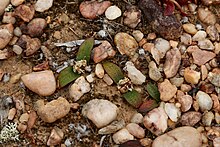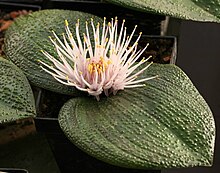Massonia
| Massonia | ||||||||||||
|---|---|---|---|---|---|---|---|---|---|---|---|---|

|
||||||||||||
| Systematics | ||||||||||||
|
||||||||||||
| Scientific name | ||||||||||||
| Massonia | ||||||||||||
| Thunb. ex Houtt. |
Massonia is a genus within the family of asparagaceae (Asparagaceae). The approximately 26 species thrive in arid southern Africa .
Description and ecology
Massonia species grow as perennial herbaceous plants . These geophytes form onions as persistence organs , which have a tunic. They form two broad, fleshy, opposite leaves per season that lie flat on the substrate. Almost axeless inflorescences with numerous individual flowers appear between the leaves . The round seeds are black.
Massonia species bloom in our winter and largely move in in summer. Pollination of Massonia depressa occurs at night by rodents.
Distribution and location requirements
Massonia species occur in the arid regions of southern Africa . Four types are floral elements of the Capensis . Depending on the climatic conditions, they are adapted to drought in the southern hemisphere winter and low humidity in the southern hemisphere summer and autumn. They grow on sandy soil.
Systematics
The genus Massonia was established in 1780 by Carl Peter Thunberg in Maarten Houttuyn : Natuurlijke Historie ... , Volume 12, Part 2, p. 424. Type species is Massonia depressa Houtt. . The genus name Massonia honors Francis Masson , who was collecting plants in South Africa at the same time as Carl Peter Thunberg .
The species of the genus Whiteheadia were incorporated into the genus Massonia in 2004 . According to R. Govaerts, however, this genus should be maintained with a single species Whiteheadia bifolia (Jacq.) Baker .
The genus Massonia belongs to the subtribe Massoniinae from the tribe Hyacintheae in the subfamily of Scilloideae within the family Asparagaceae . It was previously classified in the Hyacinthaceae or Liliaceae families.
The genus Massonia includes about 26 species:
- Massonia amoena Mart.-Azorín, M.Pinter & Wetschnig : It occurs in the eastern former Cape Province. It was first described in 2014.
- Massonia angustifolia L.f. : It occurs in the former Cape Province.
- Massonia bakeriana M.Pinter, Mart.-Azorín & Wetschnig : It occurs in the northern former Cape Province.
- Massonia calvata Baker : It occurs in the south-central former Cape Province.
- Massonia citrina M.Pinter, German, U.Müll.-Doblies & D.Müll.-Doblies : This endemic occurs only in the Wabooms Mountains between Worcester, Robertson and De Doorns in the Western Cape . It was first described in 2013 on the basis of cultivated specimens and very little is known about this species and only one site is known from which the type material originates.
- Massonia dentata Mart.-Azorín, VRClark, M.Pinter, MBCrespo & Wetschnig : It occurs in the western former Cape Province.
- Massonia depressa Houtt. (Syn .: Massonia grandiflora Lindl. , Massonia latifolia L. f. ): It iswidespreadin the South African provinces of the Free State , North, West and East Cape . The stocks are considered stable.
- Massonia echinata L. f. (Syn .: Massonia bolusiae W.F.Barker , Massonia concinna Baker ): It is common in the South African provinces of the North, West and East Cape. The stocks are considered stable.
- Massonia gypsicola Mart.-Azorín, M.Pinter, MBCrespo, M.Á.Alonso & Wetschnig : It occurs in the western former Cape Province.
- Massonia hirsuta Link & Otto : It occurs in the southern former Cape Province.
- Massonia jasmine flora Burch. ex Baker : It thrives in the summer rain areas in Lesotho in the South African provinces of Free State, Gauteng , North Cape and North West .
- Massonia latebrosa Masson ex Baker : It occurs in the southwestern former Cape Province.
- Massonia longipes Baker : It occurs in the Western Cape.
- Massonia mimetica Mart.-Azorín, M.Pinter, MBCrespo & Wetschnig : It occurs in the northern former Cape Province.
- Massonia obermeyerae Mart.-Azorín, APDold, M.Pinter & Wetschnig : It occurs in the former Cape Province.
- Massonia pseudoechinata Mart.-Azorín, M.Pinter & Wetschnig : It occurs in the northern former Cape Province.
- Massonia pustulata Jacq. : It occurs in the Western Cape.
-
Massonia pygmaea Schltdl. ex Kunth : There are two subspecies:
- Massonia pygmaea Schltdl. ex Kunth subsp. pygmaea (Syn .: Massonia heterandra (Isaac) Jessop ): It occurs in the Western Cape.
- Massonia pygmaea subsp. kamiesbergensis U.Müll.-Doblies & D.Müll.-Doblies : It occurs in the North Cape.
- Massonia roggeveldensis Mart.-Azorín, M.Pinter & Wetschnig : It occurs in the northern former Cape Province.
- Massonia saniensis Wetschnig, Mart.-Azorín & M.Pinter : It occurs in Lesotho.
- Massonia sempervirens U.Müll.-Doblies, G.Milkuhn & D.Müll.-Doblies : It was first described in 2010 using cultivated specimens from the Western Cape.
- Massonia sessiliflora (Dinter) D.Müll.-Doblies & U.Müll.-Doblies : It is common from Namibia to the North Cape.
- Massonia setulosa Baker : It occurs in the western former Cape Province.
- Massonia tenella Sol. ex Baker : It occurs in the west-central former Cape Province.
- Massonia thunbergiana Wetschnig, Mart.-Azorín & M.Pinter : It occurs in the northern former Cape Province.
- Massonia wittebergensis U.Müll.-Doblies & D.Müll.-Doblies : It is distributed in the Drakensberg in Lesotho and in the Eastern Cape.
No longer counted in this genus:
- Massonia bifolia (Jacq.) JCManning & Goldblatt => Whiteheadia bifolia (Jacq.) Baker
- Massonia etesionamibensis (U.Müll.-Doblies & D.Müll.-Doblies) JCManning & Goldblatt => Desertia etesionamibensis (U.Müll.-Doblies & D.Müll.-Doblies) Mart.-Azorín, M.Pinter & Wetschnig
use
Few Massonia species are ornamental plants for pot culture in cold rooms.
supporting documents
literature
- Friedrich Gottlieb Dietrich : Complete lexicon of gardening and botany or alphabetical description of the construction, maintenance and use of all domestic and foreign, economic, official and ornamental plants . Volume 6, Berlin 1806.
- John Charles Manning, Peter Goldblatt, Dee Snijman: The Color Encyclopedia of Cape Bulbs . 2002, ISBN 0881925470 .
- Martin Mergili: The Vegetation of Grootbos Nature Reserve: Fynbos and Forest Ecosystems at the Southernmost Tip of Africa . 2008, ISBN 3639030583 .
Individual evidence
- ↑ a b c d e f g h i j k l m n o p q r s t Rafaël Govaerts (Ed.): Massonia. In: World Checklist of Selected Plant Families (WCSP) - The Board of Trustees of the Royal Botanic Gardens, Kew . Retrieved July 28, 2018.
- ↑ Steven D. Johnson, Anton Pauw, Jeremy Midgley: Rodent Pollination in the African Lily Massonia depressa (Hyacinthaceae). In: American Journal of Botany. Volume 88, Number 10, 2001, pp. 1768-1773.
- ^ Massonia at Tropicos.org. Missouri Botanical Garden, St. Louis, accessed April 13, 2013.
- ↑ John Manning, Peter Goldblatt, Michael F. Fay: A revised generic synopsis of Hyacinthaceae in sub-Saharan Africa, including new combinations and the new tribe Pseudoprospereae. In: Edinburgh Journal of Botany . Volume 60, number 3, 2004, pp. 533-568 ( doi: 10.1017 / S0960428603000404 ).
- ^ Massonia in the Germplasm Resources Information Network (GRIN), USDA , ARS , National Genetic Resources Program. National Germplasm Resources Laboratory, Beltsville, Maryland. Retrieved April 13, 2013.
- ↑ a b c d e f g h i j k Species list for Massonia in the Red List of South African Plants . Retrieved November 1, 2014
- ↑ a b W. Wetschnig et al .: Massonia pustulata Jacq. 1791 and M. longipes Baker 1897 (Hyacinthaceae), two frequently misunderstood species - or how M. pustulata became depressed. In: Stapfia. Volume 97, Linz 2012, pp. 210–221, PDF on ZOBODAT Also full-text PDF on researchgate.net.
- ↑ Data sheet of the Pacific Bulb Society



